Are you already using Facebook chatbots in your marketing mix? If not, you might want to consider getting one today.
Why?
Because Facebook bots continue to change how consumers interact with brands on the largest social media platform.
There are over 300,000 Facebook Messenger Chatbots active in the market today. On a messaging platform with more than 2.32 billion monthly active users worldwide. Facebook Messenger users represent a huge portion of the eCommerce consumer industry—and connecting with your Facebook audience via a Messenger bot is an absolute win.
Facebook Marketing chatbots help companies start conversations with customers, collect information, make recommendations, and solve simple issues quickly.
And we could list out all the benefits here for you. But we figured it’s better to show you the best Facebook ecommerce chatbot examples and what they can do.
1. Kindred Bravely
Thanks to Facebook Messenger bots, “conversational commerce” (the intersection of shopping and messaging apps) is now a reality. A great example of this is Kindred Bravely.
Kindred Bravely is an eCommerce store for new moms. They offer nursing clothes, pajamas, and other clothing and accessories for any woman with an infant.
When you first interact with the chatbot, it’s clear from their very first menu that the focus of this bot is on helping you to shop for their products.
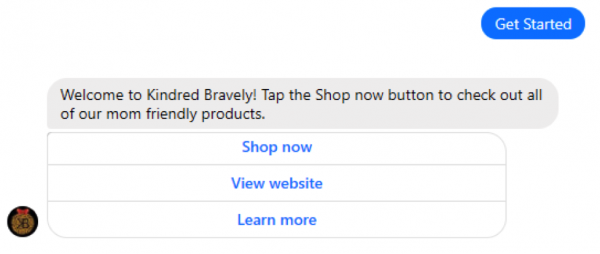
Chatbots like Kindred Bravely replace the clunky shopping experience on a website—requiring the use of multiple menus and filters—with a more conversation-driven experience.
Users can simply click the “Shop Now” and bring up Kindred Bravely’s most popular product categories.

And when you “Browse” any of those categories, you’ll see a variety of products that fit within that category.

Now you have 2 choices: you can “View details” (which opens the product detail page in a new tab), or “Choose options.”
“Choose options” allows you to customize the product right inside of Messenger. For this maternity nightgown, the bot first asks what color you prefer.
(Notice how they use the gallery format to show you what each of the colors looks like).
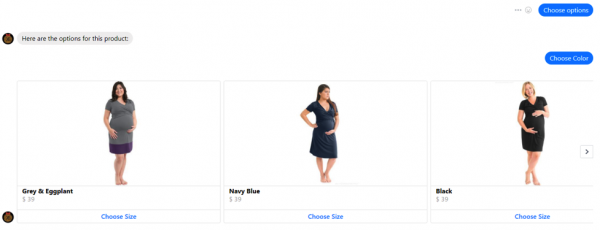
Then you can choose from the different sizes available.
Notice how this Facebook bot follows the same process as a live salesperson. First, they start by getting a general idea of what you’re looking for. Then, they help narrow down your preferences by asking specific questions—showing you a range of options at each step along the way.

Clicking “Buy Now” opens the shopping cart in a new tab with your order already entered and ready to go.
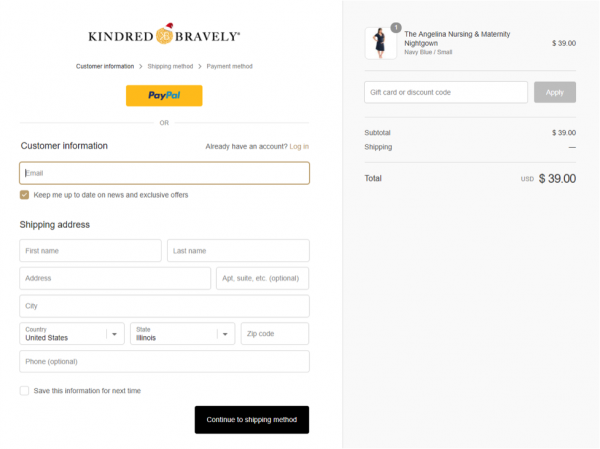
Near the end of your checkout, Kindred Bravely even gives you the option to receive order updates via Facebook Messenger—so you can receive your order confirmation and shipping updates right in the Messenger app.
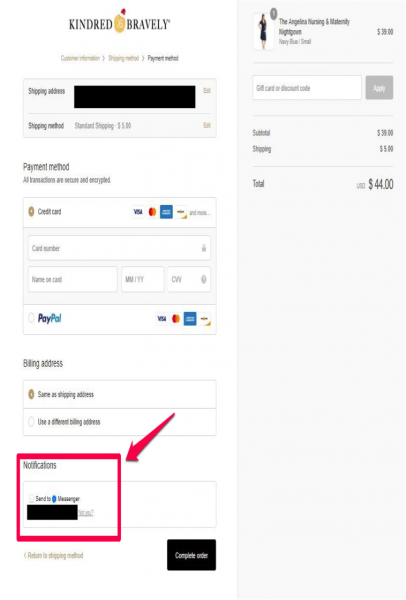
But this Messenger chatbot does more than simply give you another way to make a purchase.
For one thing, Kindred Bravely makes use of natural language keywords to make their bot as interactive as possible.
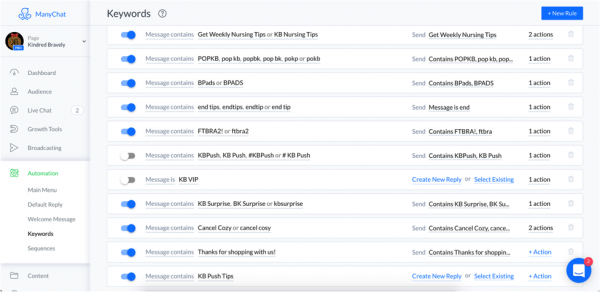
So when a user types the keyword “get weekly nursing tips,” they subscribe to a sequence with weekly breastfeeding tips.
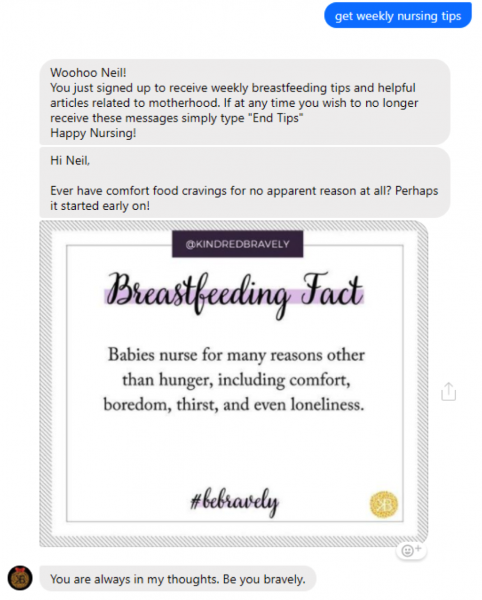
A quick look at the Sequences section of this chatbot reveals that they are taking full advantage of the ability to launch subscribers into focused sequences for events such as sales and product launches.
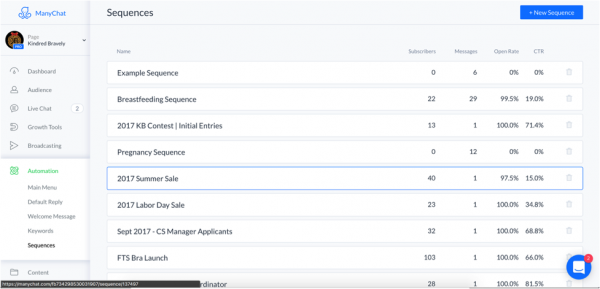
Finally, like any good Facebook chatbot, Kindred Bravely offers quick & easy service through the keyword “customer service.”
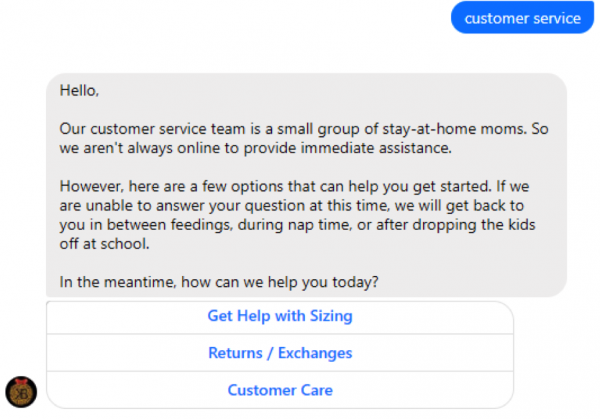
This makes it easy to reach out if you have questions or need help with your order—without having to search for a hidden “Contact” page, open a support ticket, or wait on hold for a phone representative.
2. Molly Mahoney – The Prepared Performer
Molly recently posted a case study on how she used ManyChat and Facebook Live to reach 1 million organic users.
So we thought it would be a good idea to take a deeper dive into how she uses ManyChat to engage with her target audience on social media.
When you first interact with the Mollybot, she starts off by letting you know that you’re talking a chatbot. She also gives you some quick instructions on how to converse with it.
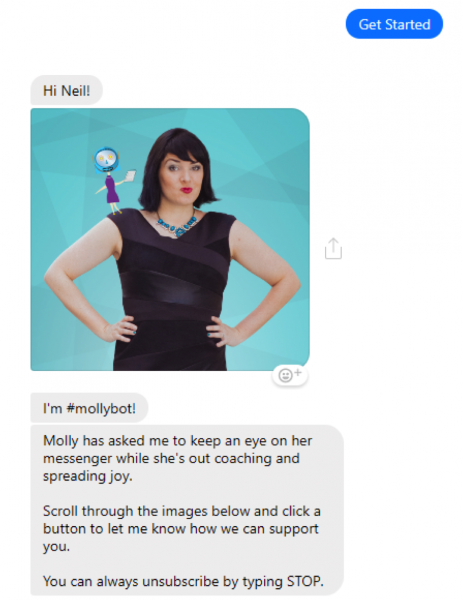
Then Molly showcases some of her top content categories using the gallery format.

Depending on which button you click, different things will happen. For example, clicking “Show Me!” under “Live Video Tips” brings up a menu with more options.
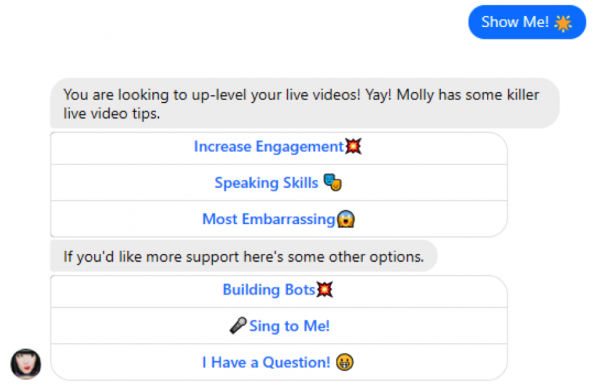
What Molly is really doing here is showcasing her best content that’s relevant to the topic. Some buttons, such as “Increase Engagement,” open a Facebook video in a new tab.
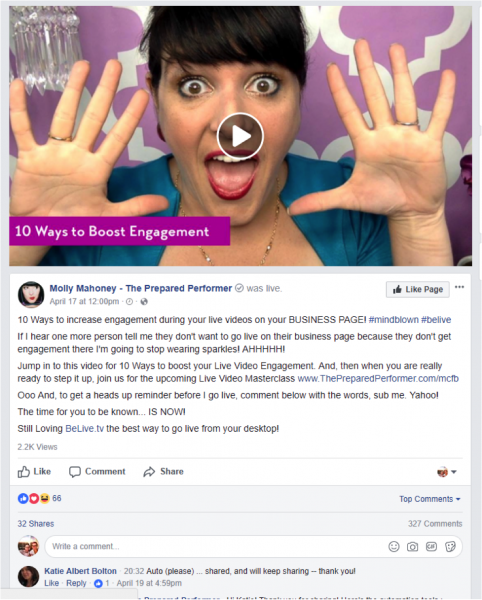
Others begin an interactive teaching sequence. The “Building Bots” button, for example, tells you more about how she uses chatbots to engage her visitors.

And just like Kindred Bravely, Molly also makes it easy to reach out to her with comments/questions and receive a personal response.

This is always a good idea, since no chatbot will ever be able to respond to every possible question people might have for you.
3. Kaimana Jerky
Kaimana Jerky is a great example of how even small new companies can use Facebook Messenger and ManyChat to reach new customers and grow their business.

It’s a fairly simple bot. Probably the biggest function it serves is giving customers an easy way to contact the business with questions or comments—just click “Message our team”.
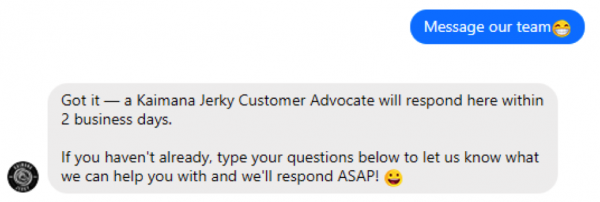
A quick look under the hood reveals that Kaimana’s customers are happy to chat with the company on Facebook Messenger.
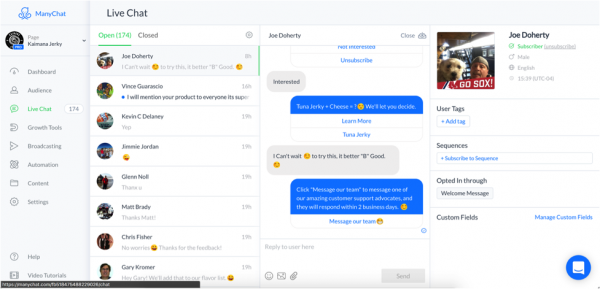
You’ll also notice that the menu contains links to 2 of Kaimana’s product category pages and an “About Us” page.
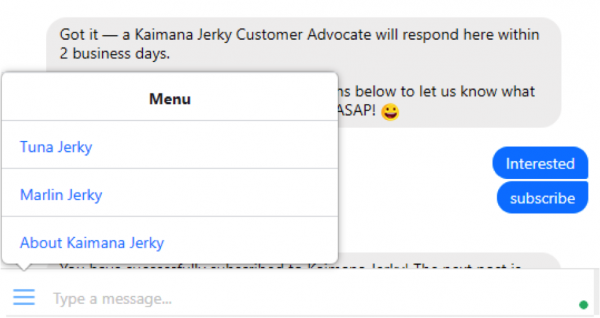
Lastly, I’d also like to point out that, like so many of the other chatbots in this post, Kaimana makes it easy to subscribe and unsubscribe for updates and new message notifications.

This is important because you certainly don’t want to annoy people who don’t want to hear from you. Giving people a clear opt-out keyword is a great way to help maintain your ManyChat list hygiene and ensure that you’re only sending messages to interested prospects & customers.
4. How Much Bot
I want to give a quick example of how you can use a chatbot to deliver content to your users in a way that’s simple, straightforward, and effective.
How Much Bot is a quick video course that teaches you how to create an automated quoting bot to get more clients.
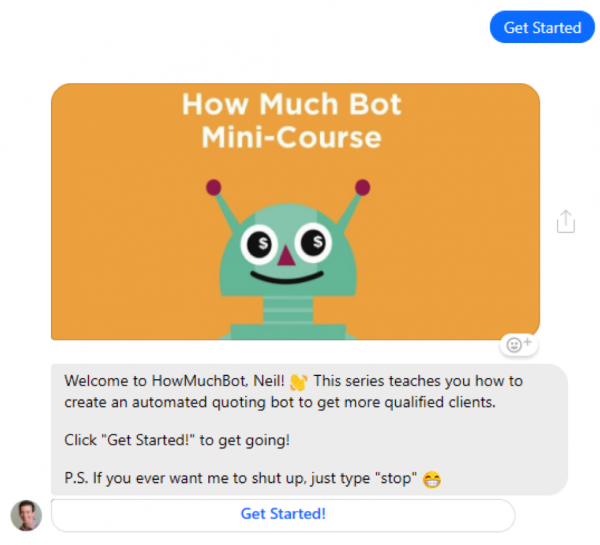
And when you click “Get Started!”, you’ll be shown a gallery with all 6 lessons in the course.
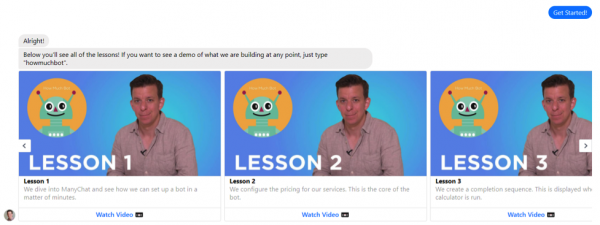
When you click “Watch Video” beneath a lesson, the Facebook video opens in a new tab where you can watch and engage with the content.

How Much Bot doesn’t stop there, though. While he has your attention, creator Nick O’Neill takes a second to qualify you as a lead for his company BotPartners. If you indicate that you’d like help building a bot, you’ll be qualified as a lead after three easy questions.
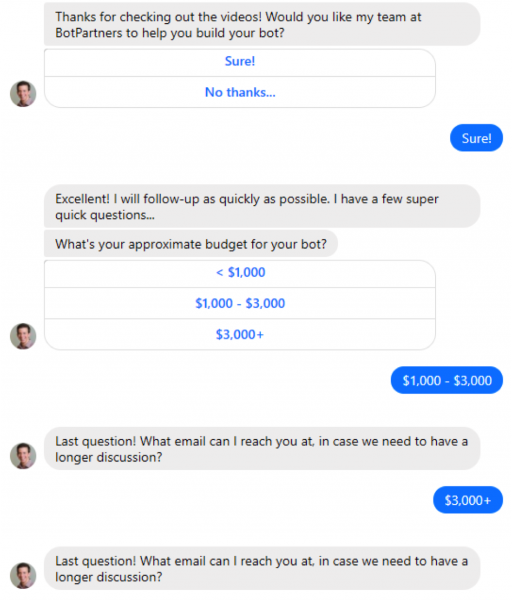
This chatbot is exciting for a couple reasons.
First of all, this is one of the first hints we’re seeing of video courses and even potential membership “sites” that can be run entirely inside of Facebook Messenger.
And second, it’s a great example of how to generate social media leads on autopilot for your business! Notice the formula O’Neill follows in this chatbot: first, deliver value while showcasing your expertise. Then capture your interested leads’ contact information for later follow-up by your sales team.
(RELATED: How to Send Facebook Messenger Broadcasts Using ManyChat)
5. The Wall Street Journal
The Wall-Street Journal (WSJ) is one of the world’s most recognized publishers covering topics related to business, finance, & economics.
As such, the main purpose of their chatbot is to deliver news that fits into one of those categories.
When you first interact with the WSJ Messenger bot, they do something very smart: they start the conversation by asking you to subscribe for daily updates.

This is a great way to set expectations right up-front while getting the user’s consent to send regular messages. By capturing the user’s information from their Facebook account, WSJ is already well on their way to building their retargeting pool.
From there, WSJ’s content splits into two main categories: headlines/news and company/stock updates.
When you ask to see the news, WSJ uses a carousel format to showcase the day’s biggest new stories in the most visual way possible:
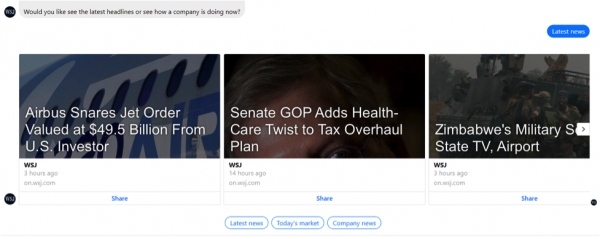
Clicking on one of these stories will open it right inside of Messenger, allowing you to get your news without having to toggle back and forth between apps on your phone.

When you ask for stock market data, the chatbot begins at the highest level by showing the performance of the various indexes:

From here, you can quickly drill down to get what you’re looking for.
The “More info” link will open a new tab full of stock market quotes, while the “Leaders & Laggards” link will open another carousel of high- and low-performing companies.
WSJ also makes it easy to stay updated on the performance of any index market or individual company.
Want to get daily updates on the S&P 500? Or maybe you own some shares of Nike and want to stay up-to-date on how your stock is doing.
Just click “Follow” and WSJ will send you regular updates right inside of Messenger.
6. Poncho
Think back to the last time you were caught in the rain by surprise.
Wouldn’t it have been nice if somebody sent you a message earlier that morning reminding you to bring an umbrella?
That’s the idea behind Poncho, the chatbot that has quickly grown to become one of the most popular on Facebook. And for good reason:
It does a fantastic job of combining great usable content with fun branding.
Right away when you interact with Poncho, you’re greeted with a fun gif that gives you an idea of what this chatbot is all about:

The main goal of Poncho is to give you regular weather updates. To do that, they first have to determine your location (which you can type out manually or simply allow Location Access to let Poncho determine it automatically).
Once Poncho knows your location, it gives you different options for receiving regular alerts. You can set up morning alerts, evening alerts, and severe weather alerts.
Poncho will even send you a daily “running forecast,” letting you know if it looks like a good day to go for a jog or not.

In short, Poncho is a simple and straightforward chatbot that doesn’t waste any time with unnecessary options.
And of course, it also responds to any typical weather-related question:
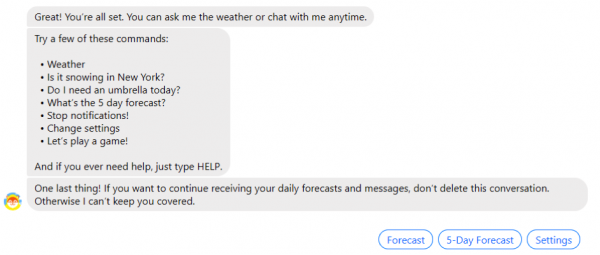
Poncho is a great example of a chatbot that’s focused on solving one specific problem in a way that’s fun and easy to use on social media.
7. eBay ShopBot
Thanks to Facebook Messenger, “conversational commerce” (the intersection of shopping and messaging apps) is finally becoming a reality.
And for a great example, look no further than the eBay ShopBot.
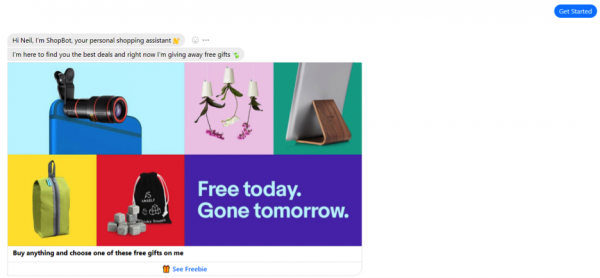
Chatbots like ShopBot aim to replace the clunky shopping experience on a website—requiring the use of multiple menus and filters—with a more intuitive, conversational experience.
And just like the Wall Street Journal chatbot, eBay makes great use of carousels to display products and categories:

When you tell the ShopBot that you want to shop for a certain category of products, such as “Hot Sneakers,” it will show a range of options for you to browse.

When you click “more like this” underneath a product, you’ll see a variety of different options for that exact product.
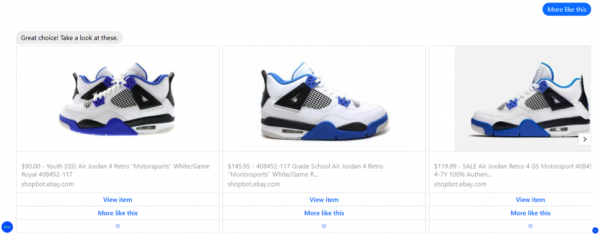
When you click “view item,” a product page opens up in the same chat window:
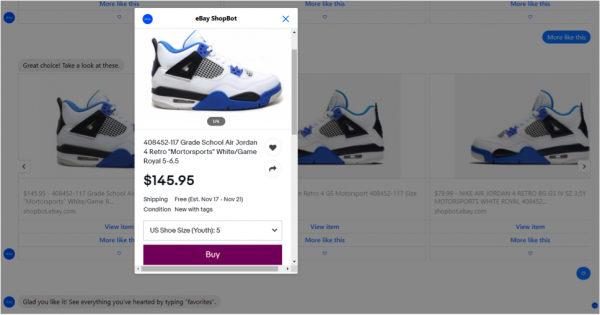
From here you can complete your purchase right inside of Messenger.
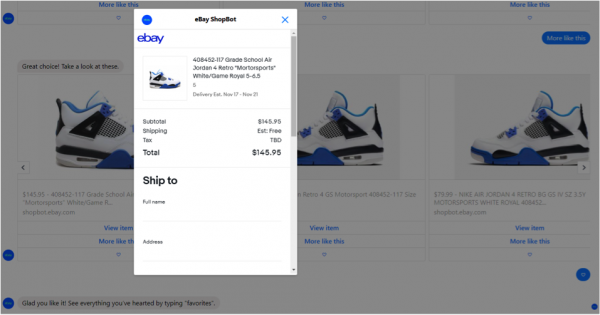
If you have something more specific in mind, you can always use a manual search to tell the ShopBot exactly what you’re looking for. For example: “I’m looking for polarized sunglasses”.

The conversation then leads to eBay’s ShoptBot showing you a few results. If you don’t see what you’re looking for, the chatbot will proceed to ask you a series of questions to help you narrow down your choice.
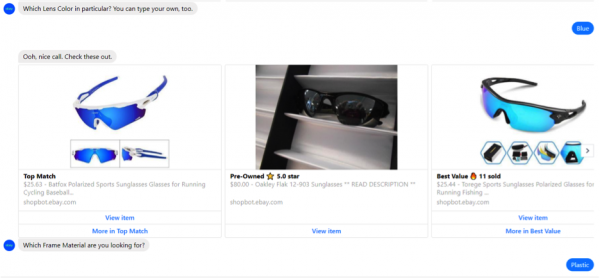
The more questions you answer, the more narrowed-down your suggestions will be.
In a way, this chatbot follows the same process you’d go through with a live salesperson in a store. First they’d start by getting a general idea of what you’re looking for, then they’d begin to narrow down your preferences for by asking more and more specific questions—showing you a range of options at each step along the way.
8. HealthTap
Number 7 on our list, the eBay ShopBot, showed you how a chatbot can replace the normal shopping experience with a more conversational equivalent. Now you’ll see how HealthTap does the same thing in the medical news & health information space.
HealthTap focuses on a question/answer format, fielding medical questions and providing answers from real doctors. When you type a medical inquiry or symptoms, like “lower back pain,” HealthTap shows you a few relevant questions that have already been answered.
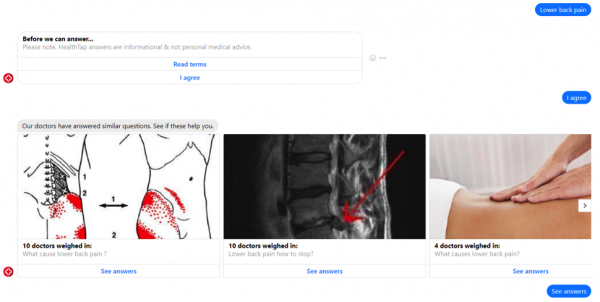
When you click on the most relevant question, you’ll get a list of answers that have been provided by doctors.

From there, simply click on an answer to read the doctor’s reply to the question.
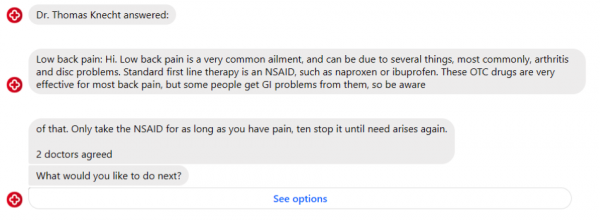
Of course, there’s always the chance that your particular question hasn’t already been answered yet on HealthTap. If that’s the case, just tell the HealthTap chatbot to send your conversation to a doctor.

HealthTap will submit your question to their network of over 108,000 U.S. doctors, resulting in an answer within one day.
9. Instalocate
Instalocate is another growing and popular chatbot that serves a practical purpose for many people: It keeps you up-to-date on flight changes and other alerts inside Messenger.
This makes it a handy way to track flights, whether you’re flying or simply picking someone up at the airport.
When you first interact with Instalocate, you’ll see a menu of some of the options available within the app.
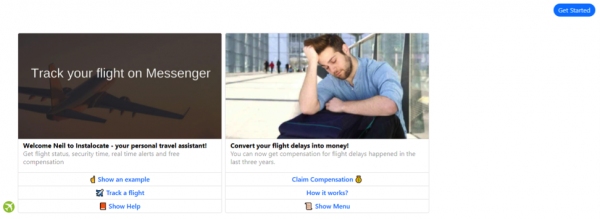
To track a flight, simply enter the flight number. Instalocate will instantly look up the flight details.
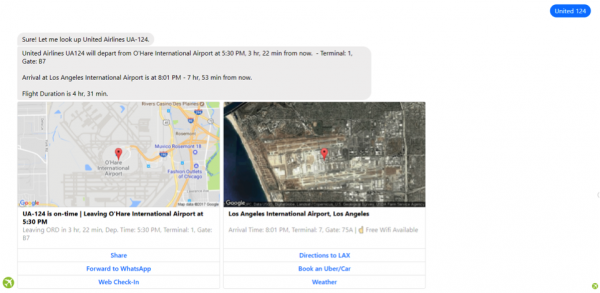
It will also send you a message when there’s a change with the flight (a delay, taking off, landing, and so on).

Instalocate makes it easy to share your flight status with friends or family, which is especially helpful when you have someone waiting to pick you up after you land and you want to let them know when your flight is due to arrive.

If your flight happens to be canceled or delayed by 3 hours or more, Instalocate even provides a link where you can claim compensation from the airline.

And when your flight finally lands, you can even use Instalocate to book an Uber or Lyft to your final destination.

So what makes Instalocate such a great chatbot?
Among other things, Instalocate does a phenomenal job of anticipating a traveler’s questions and providing the exact information that the traveler is looking for—at the exact moment when they’re liable to want it.
10. Job Bot
Looking for a new job?
Then you’ll want to check out Job Bot.
This job-hunting chatbot puts a new spin on the old task of looking for a new job. And as you might expect, it does so in an easy, conversational manner.
To get started, Job Bot needs two pieces of information: your location and a search keyword. (And if you’re looking for a position in more than one city, no problem— Job Bot can expand its search for anyone willing to relocate).
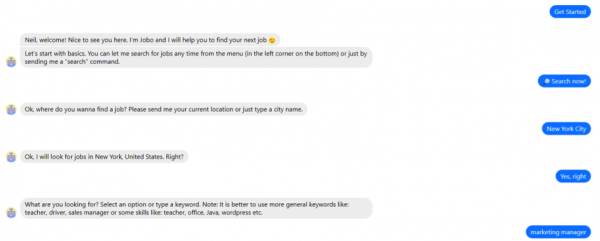
That’s all the information this chatbot needs to deliver the top job results in your area, using an easy-to-scan carousel format.
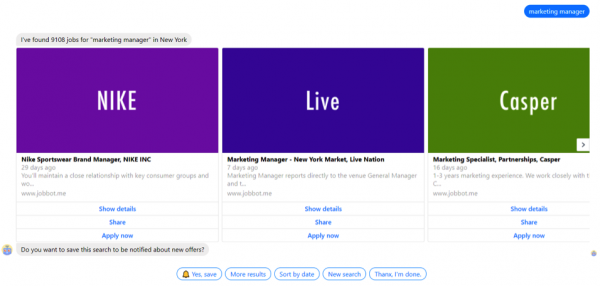
Another way to find new job openings as soon as they’re posted is to sign up for job alerts, which is a really helpful feature for anyone who’s serious about finding a job. And Job Bot smartly asks you this after you search for a job, making it easy to get regular job posting updates on social media.

Job Bot also allows for one-click job submissions. To do that, however, you have to set up a career profile.

You’ll need to answer a few easy questions, then either specify your LinkedIn profile or upload a resume. Then you’ll be able to easily apply to jobs directly from the conversation with a single click.
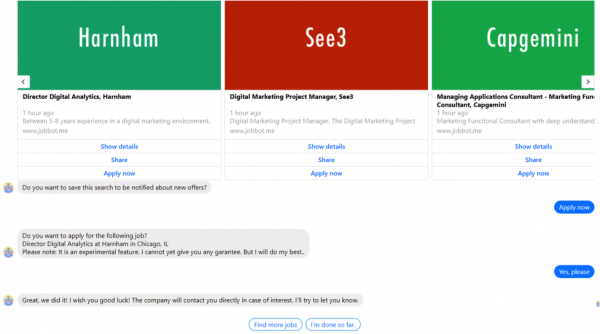
What does Job Bot do well?
For starters, it serves a real need. People need to look for jobs. And for many, Facebook Messenger provides a low-friction place to do it.
Add in how ridiculously easy it is to apply to jobs with just a single click, and you can start to see why this bot would be such a hit with job seekers.
11. Christopher Bot
Some people reading this list may have the mistaken impression that only big brands and well-funded companies can afford to build an effective chatbot for their marketing department. But nothing could be further from the truth. It’s possible to use a chatbot builder to produce an effective messenger bot.
And for proof of that, look no further than Christopher Bot.
Christopher Bot was built by a 14-year-old boy from Canada named Alec Jones, who was recently featured on the BBC for his outstanding job creating the chatbot. Not only is it easy & intuitive to use, but it also serves a useful purpose:
It reminds you to do your homework!
When you sign up with Christopher Bot, it will ask you to connect with a simple website. From there, you fill out a short & simple form telling the bot which classes you have.
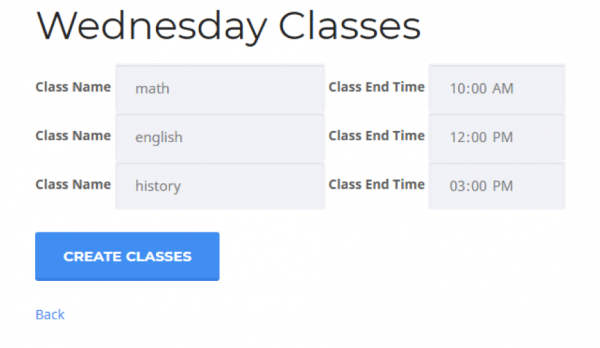
Once you’ve added your class schedule, you’re all set. Then, once your next class is over, Christopher Bot will start a conversation asking if you have any homework, and if so, when the due date is.

To see your list of homework, you can always head over to Christopher’s website where your homework will be listed on the schedule.

Of course, you can always simply ask the bot for a list of your homework. And the bot will also send you automatic reminders to get your homework done.

The Christopher Bot provides a brilliant solution to a very common problem. Namely: kids forgetting to do their homework!
Messenger turns outs to be a great medium for solving a problem like this. Why? Because it can easily send automated reminders, based on the homework’s due date, and deliver those reminders in a place where kids are sure to see them.
And if a 14-year-old kid could create their own chatbot…just think what you can do!
What Do These Facebook Chatbots Have in Common?
When looking through this list of Facebook chatbots, one of the questions you might find yourself wondering is:
What do these chatbots have in common?
At first glance, it’s a tricky question. There may not seem to be any universal best practices.
But when you look closer, you can find a few things that all of these chatbots do well:
Use Short, Conversational Messages
You’ll notice that almost every message in these chatbots is short and easy to read.
There aren’t any long-winded paragraphs. Instead, almost everything is communicated in quick, one-sentence messages—just like most of our real-life conversations.
And the best chatbots also manage to do so using a conversational tone that helps brand the company and makes the user smile at the same time.
Ask for Permission
Most, if not all, of these chatbots explicitly ask the user if they would like to receive regular updates—whether it’s news headlines, weather alerts, or new job postings.
You never want to surprise users with unwanted messages. Make sure they actually want the updates your chatbot provides, and then, get their expressed permission to send them regular updates.
Let them know what to expect from you—and provide an easy way to opt-out anytime they wish.
Design with the End User in Mind
Most importantly, these chatbots have all been created with the end user in mind, and designed to be as helpful and intuitive as possible for the human on the other end.
You can tell the creators have spent a lot of time thinking about what their users are looking for and what they actually need at various times.
It’s no surprise that Instalocate gives you the option to book an Uber after your plane lands.
Or that Poncho lets you know if today is going to be a good day for a jog.
Or that Christopher Bot asks about your homework right after each of your classes is over.
These chatbots have been designed to help real people with real problems, which drives any successful social media marketing strategy. And if you want to create a chatbot that engages people and creates more business for your company, that’s what you have to do, too.
Want to Build a Facebook Messenger Bot Like These?
If this list of Facebook chatbots has left you feeling inspired, here’s a bit of good news:
You can get started creating your own Facebook chatbot in minutes…and it’s 100% free!





![11 Best Facebook Chatbots That Engage Customers [2021]](/blog/_next/image/?url=https%3A%2F%2Fmanychat.com%2Fblog%2Fwp-content%2Fuploads%2F2019%2F05%2FBest-Facebook-Chatbots.png&w=3840&q=100)